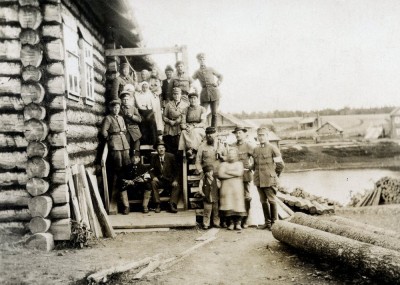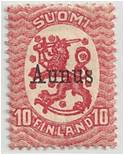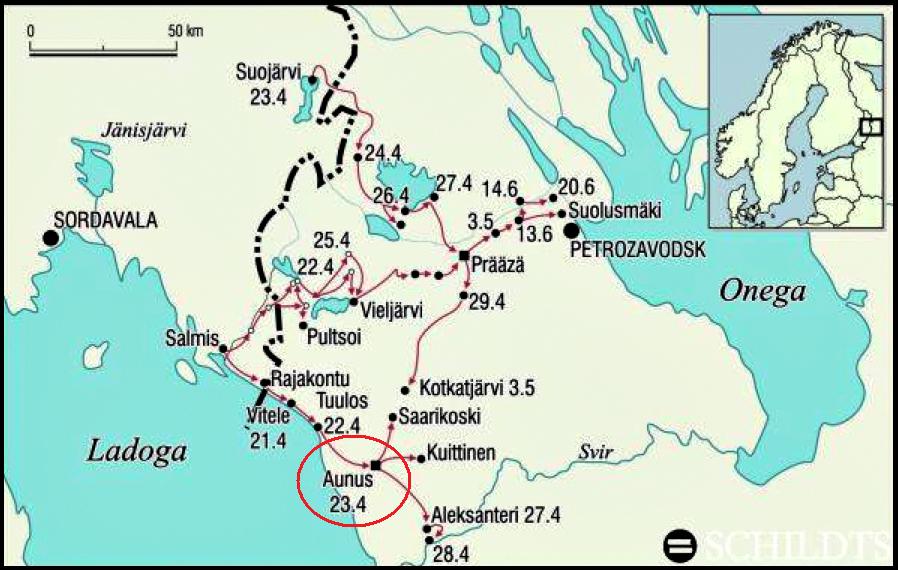ALBUM – view my Aunus, Finnish Occupation Album
TRANSITION CHART – North and West Russia (including Finland)
Fast Facts
Region: Russia Area
Group: Russian Revolution
Classification: Revolutionary Entity
Prior Regime: Russian Soviet Federated Socialist Republic
Key Dates:
1917, Dec 6 – Finland declares independence from Russia
1918, Dec – Republic of Finland is formed with the defeat of the Germans in WW1
1919, Apr 21 – Finland invades Eastern Karelia (Aunus is the capital)
1919, Sept – Finland is driven back by the Russians
1920, Oct 14 – Treaty of Tartu signed agreeing on final borders between Finland and Russia
Following Regime: Russian Soviet Federated Socialist Republic
Scott Catalogue: (Russia, Occupations, Aunus) #N1-N8
Pick Catalogue: none
History

On 6 Dec, 1917, shortly after the October Revolution in Russia, Finland declared independence from the Russians. After a brief civil war between the reds (Bolsheviks) and the whites (ant-Bolsheviks) the Germans intervened, giving victory to the whites, and declared Finland as a Protectorate of the German Empire. After the defeat of Germany in World War 1 on Nov 1918, Finland became an independent Democratic Republic with the first parliamentary election being held on 3 Mar, 1919.
Aunus, which is Finnish for Olonets, was the administrative center of the Olonetsky District of Karelia (Eastern Karelia). Soon after Finland gained independence from the Russians, the citizens of Karelia, which were culturally aligned with the Finns, began requesting support to join Finland. After a couple of unsuccessful forays, Finnish troops crossed into Eastern Karelia on 21 Apr, 1919 with the objective to unite Eastern Karelia with the rest of Finland. The Finns sorely underestimated the troops necessary to take Eastern Karelia, anticipating support from the local population as well as from British Troops which occupied portions of the region.
The Russian Red Army and the Finnish Red Guard (remnants from the civil war), rallied their troops, and in June of 1919 began driving back the Finnish forces. By Sept, 1919, most of the Finnish forces were driven back with only a small gain from the invasion. Finland and the Russians finally agreed on common borders in the treaty of Tartu, signed on 14 Oct, 1920, and Finnish troops were required to withdraw to the agreed borders by 14 Feb, 1921. The borders agreed in the treaty, essentially split the Karelia region, in addition to giving North Ingria to the Russians.
The Karelia region continued to be a major point of conflict between Finland and Russia including the East Karelian Uprising (1921–1922) when the Finnish government allowed volunteers to take part in the conflict, when the Soviet Union broke the treaty of Tartu in 1939 starting the Winter War, and when Finland invaded and occupied Eastern Karelia during the Continuation War in 1941-1944.
Stamps
 ALBUM
ALBUM
During the short occupation period, 8 denominations of the Finnish coat of arms stamps of 1917 were overprinted with “Aunus” in black. Two printings were made, the first on 27 Jun, 1919 and the second on 18 Aug, 1919. The stamps were issued by local authorities primarily to support the volunteer corps, and to provide moral support for their anticipated “independence”.
The stamps of Aunus were valid for postage from 7 July through 15 October, 1919.
Banknotes
none
Links
The Aunus expedition in Wikipedia
The Finnish “Associate Group” and the Prolific Forgeries of Karelia, by Ed Fraser





